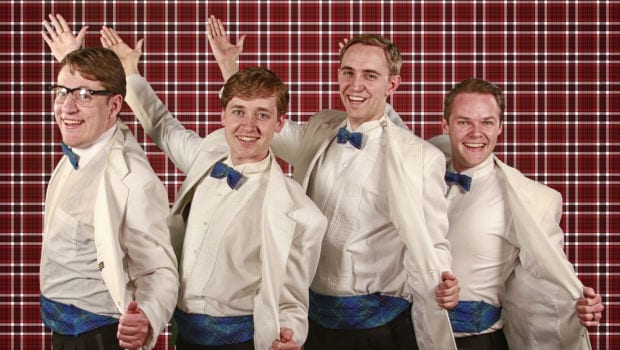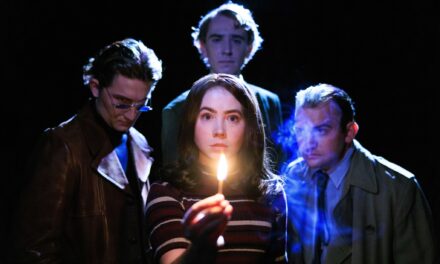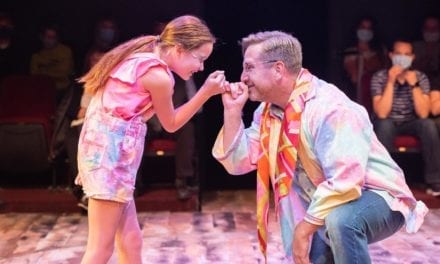PROVO — Everyone wishes they had a second chance. But the four characters of Forever Plaid never even had a first chance. On their way to a big performance, which they hope could lead to other important music gigs, the four men who make up the musical group “The Plaids” are hit by a school bus and killed. Fifty years later, the universe allows them to give the performance they missed when their lives were tragically cut short.
It’s a silly plot, but it’s enough to tie the songs in this jukebox musical together. Stuart Ross‘s script is heavy on the nostalgia and light on character development. But that’s acceptable because the entire purpose of the show is to serve as a vehicle for the actors to croon some hits from yesteryear. It’s not always clear why these characters are singing some of the pieces (such as “Chain Gang” or the Caribbean sequence), but Ross clearly never intended the show to be a character study or to contain deep philosophical meaning. And most audience members in the target demographic group (i.e., people who were young in the 1950’s and early 1960’s) would be far more interested in the songs than any dialogue in the script.
The four actors playing the Plaids embodyied the stereotypical boy-next-door singing group. Logan Bradford, as Frankie, was charismatic as he played the leader of the group. Bradford was enjoyable as a take-charge character who the others quietly looked up to. Jonathan Fifield played Smudge, the socially awkward performer whose bass voice was the anchor of many of the group’s tight four-part harmonies. Scott Sackett was Jinx, a lanky young man who is prone to nosebleeds (and even performed a solo with some tissue stuck up his nose). Sackett provided much of the comic relief, and was admirable in his portrayal of the affable Jinx. However, my favorite of the four performers was Daniel Fifield, who played Sparky. His frequent flirting with audience members (especially the way he eyed the old ladies on the front row) and his unabashed showmanship made him impossible to ignore. Thanks to the strong performance, it was obvious that Sparky loved the stage. This made his death much more tragic, and provided a little bit of depth to an otherwise lacking script.
Director Skye Cummins‘s greatest contribution to this production was the camaraderie that she built among the four actors. Skye Cummins was also superb in showing how the ensemble of the Plaids function as a group and how each character makes an important contribution (such as the support that the other three gave to Jinx during his solo). Throughout the production Skye Cummins also ensured that the characters embodied the 1950’s: sweet, lovable, and almost innocent. I felt like any one of them could have walked out of Leave It to Beaver. As music director, Ben Cummins (the director’s husband) helped the cast create a musically flawless performance. More than once my wife turned to me after hearing a chord and said, “Wow.” It was clear that both Cummins understood the importance of music in this play, and the many hours of music rehearsal with the cast clearly paid off. On the other hand, the choreography was often sloppily executed (such as in “Three Coins in a Fountain” or “Papa Loves Mambo”). While I understand that the Plaids are supposed to be nervous and out of practice, intentional mess-ups are not as funny when the actors are not in sync when they should be.
Given the intimate black box setting and the small cast, it’s not surprising that the show’s visual style was simple. The snazzy tuxedos and dinner jackets (designed by Pam Davis and Lisa Kuhni) were appropriate for the characters, and the plaid pocket squares, bow ties, and cummerbunds were a cute touch. Dan James‘s set captured the kitsch of the 1950’s and provided plenty of places for actors to hide their props when they weren’t needed. I was disappointed with the lighting (also designed by Dan James), which was limited by a small number of lighting instruments. As a consequence, there were often dark patches on the stage or shadows across the actors faces.
Finally, I must note that even though the acting was fine, the singing was superb, and I enjoyed the direction, Forever Plaid was a very unpleasant experience. This is because the temperature in the Covey Center’s Brinton Black Box was very warm when the play started, and by the time the play was half over the temperature was well over 80 degrees. An usher apologized for the temperature when the show started, but the heat became so intolerable that I could not enjoy the last third of the play (from roughly “Heart and Soul” to the end). It was grossly irresponsible for the staff at the Covey Center for the Arts to allow the performance to happen without fans or complimentary chilled water for the audience. For the actors the situation must have been worse; if this had been a professional show one of the actors would have surely lodged a complaint with the actors’ union.
Although the heat was stifling, Forever Plaid is still a nice production, and the music will give some people a walk down memory lane. The music—the most important part of a jukebox musical—sounds great, and the characters each have their own charm. But before buying a ticket, make sure that the Covey Center turns their air conditioning on.







